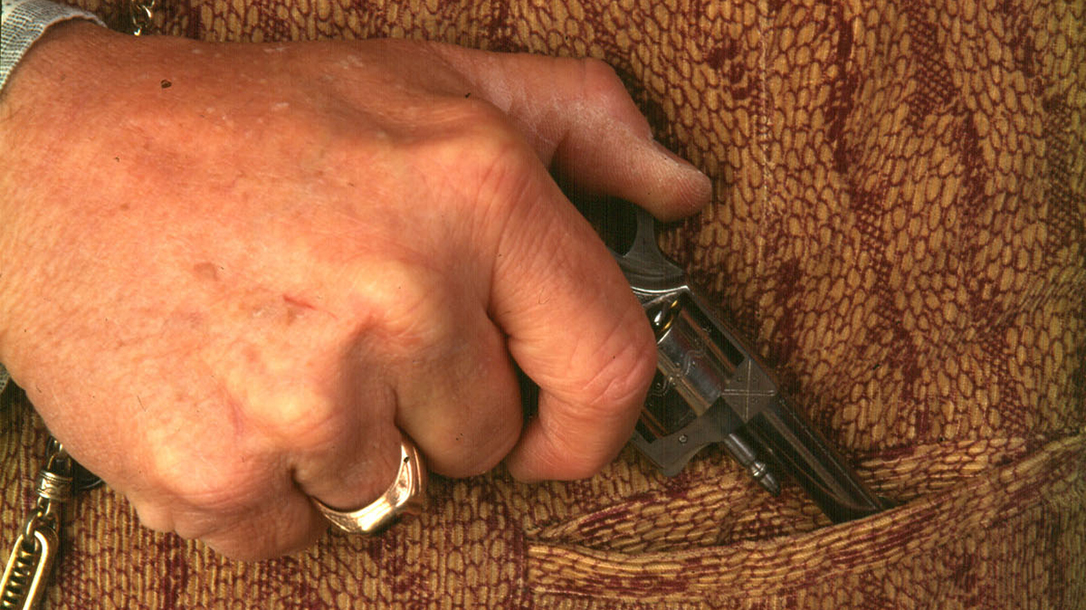When we think of the guns of the Old West, we tend to picture the big-bore revolvers like the Colt Model 1873 Single Action Army, Smith & Wesson’s top-break sixguns, and perhaps the Remington Model 1875. Nevertheless, citizens packed a myriad of small, concealable, single- and multiple-shot derringers and revolvers as well. In fact, in an 1872 issue of the Rocky Mountain News, one writer noted that a gun store in Denver was “filled with pistols—revolvers, single-barrel, Derringers and others.” Regardless of the size of the firearm, a surprising number of men and women felt that going about their daily business without being armed was downright foolhardy. Today we will look at Concealed carry- Old West style!
Concealed Carry With Cowboy Guns
In the early days of the frontier, there were few laws restricting the carrying of firearms. Most recognized it necessary to pack a weapon for personal defense in this wild, unsettled region. Many frontiersmen wore their guns openly. Yet, ironically, despite the popularly held myths about the West being “wild and woolly,” there were far fewer cases of firearms-related crimes per capita in the Wild West than in today’s more regulated big cities.
But as soon as civilization found its way onto the frontier, a number of Western communities began prohibiting the carrying of guns in public. Regardless of such local statutes, peace officers, gamblers and those who lived on the fuzzy edge of law and order—along with respectable folks—still found it advisable to pack iron. But in an effort to maintain decorum, the practice of carrying their hardware concealed from public view became de rigueur. Concealed carry became a necessity.
Advertisement — Continue Reading Below
No Holsters Needed for Old West Guns
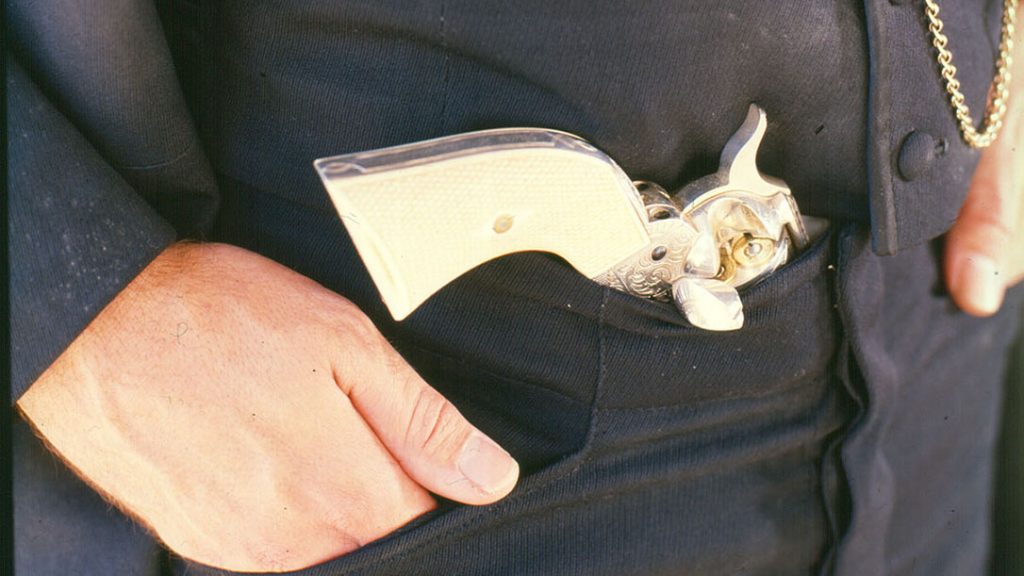
Carrying a small firearm in one’s pocket or simply tucked in the waistband (perhaps covered by a vest or coat) was among the most commonly employed method of secretly “going heeled” in the Old West. Bear in mind that the 19th century was a time when trouser belts were seldom worn and pants were held up by either the use of galluses (suspenders) or a natural fit. Oftentimes, frontiersmen would have the barrels of their long-barreled, larger-caliber sixguns lopped short for easier Concealed carry.
Advertisement — Continue Reading Below
Besides openly packing his 8-inch-barreled Smith & Wesson American .44 revolver, El Paso Marshal Dallas Stoudenmire kept a Colt Model 1860 cartridge conversion with its barrel shortened to 2½ inches as a “hideout” gun. Porter Rockwell, known as Mormon leader Brigham Young’s “Avenging Angel,” was known to carry a similar cap-and-ball Colt .44 as his concealed dealer of vengeance. Bass Outlaw, the former Texas Ranger turned deputy U.S. marshal, modified his Colt Single Action by shortening the barrel and removing the trigger. The rear portion of the trigger guard remained intact to allow for a firm grip since the gun could only fire by thumb cocking or by “fanning” it.
Hitting the Fan
Unfortunately for Outlaw, this proved to be his undoing in a gunfight with El Paso Constable John Selman on February 5, 1894. In a drunken stupor after killing a Texas Ranger, Outlaw rapidly fired this sixgun several times at Selman. But he only succeeded in wounding the lawman in the leg. Selman fired an accurate shot that proved fatal to Outlaw.
On the other hand, smaller pistols like derringers could be worn discreetly by just slipping them into one’s pocket without producing any more of a bulge than a pocket watch. Without a doubt, the most successful of these pocket-type handguns was the Remington Model 95, also known as the Double Derringer, of which an estimated 150,000 were produced between 1866 and 1935. However, when it came to the big-bore six-shooters, most pockets just didn’t work.
Advertisement — Continue Reading Below
Texas shootist John Wesley Hardin was captured in Pensacola, Florida, on July 23, 1877, after he was unable to draw his Colt Model 1860 Army cap-and-ball revolver because it was strapped to his galluses—much to the relief of the arresting officers. Wyatt Earp reportedly had a heavy canvas pocket sewn to the inside of his coat that was spacious enough to carry a Colt Single Action Army revolver without detection. Another means of secretly carrying weaponry was inside a high-topped boot. Besides knives, small- to medium-sized handguns—especially the widely sold single-shot boot pistols of the early to mid 19th century—could easily be hidden in these tall stovepipe affairs.
Unusual Methods for Concealed Carry Cowboy Guns
Perhaps the most unusual mode of Concealed carry for a sixgun was that practiced by Hardin in his later El Paso years. Eyewitness accounts state that on occasion Hardin carried a pair of double-action Colt Model 1877s in his trouser pockets—with the muzzles pointing up! In an interview appearing in the August 23, 1895 edition of the El Paso Daily Times (just four days after Hardin’s death), his landlady said, “Yes, Mr. Hardin was certainly a quick man with his guns…He would place his [unloaded] guns inside his breeches in front with the muzzle out. Then he would jerk them out by the muzzle and with a toss as quick as lightning, grasp them by the handle and have them clicking in unison.”
A unique mode of Concealed carry for the Peacemaker sans holster was to thrust it into one’s waistband, then open the loading gate. The opened gate prevented the Colt from sliding down into the pants and kept it at waist level for a fast draw. Generally speaking, the system worked well, despite one frontier sheriff’s misadventure while relying on this method. He later stated that in one gunfight he drew his Colt in such haste that he forgot to close the loading gate. He got his first shot off without a hitch, but as the revolver was cocked for a follow-up shot, a cartridge slipped rearward, out of its chamber into the loading gate area, jamming the gun. Fortunately for the lawman, his first shot settled the dispute and further gunplay was unnecessary.
Advertisement — Continue Reading Below
Donning Leather
For those who did carry small-framed revolvers or slab-sided semi-auto pocket pistols at the turn of the 20th century, leather “hip pocket” holsters often filled the bill. There were many variations of these holsters, ranging from simple folded and sewn leather sheaths—perhaps with a button or spring metal clip for attaching to the waistband or pocket wall—to more complex designs incorporating spring-loaded trigger guard retainers for added security.
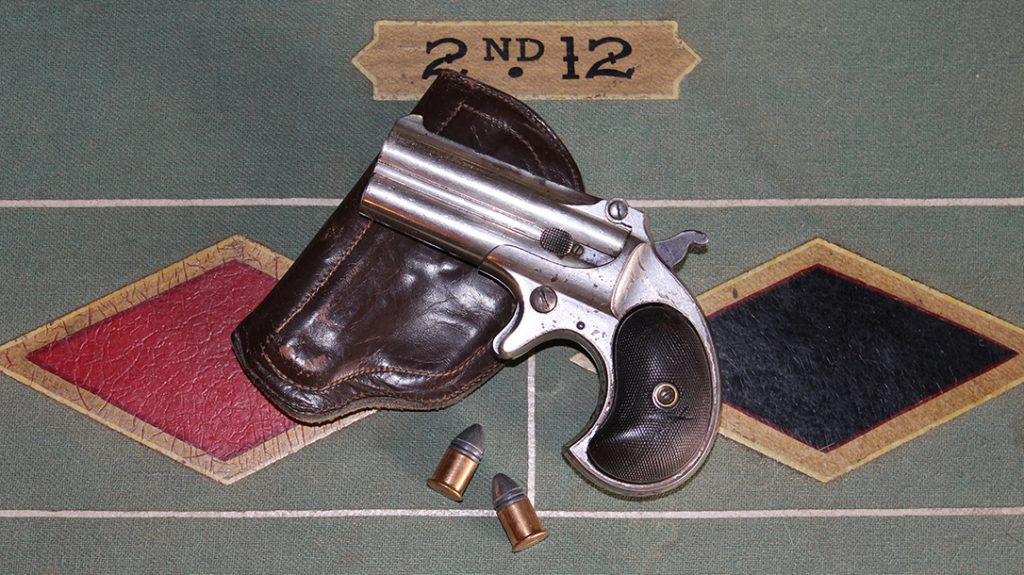
Advertisement — Continue Reading Below
A much-emulated style involved the use of a flat, rectangular piece of leather (sometimes utilizing two layers stitched together to form a stiff backing) that conformed to the general shape and size of a pocket. A sheath, sewn to the backing, followed the general contours of the revolver. This holster kept the gun in position for quick, easy retrieval. One example, patented by inventor R.G.M. Phillips in July of 1900, included a spring-loaded safety shroud over the trigger guard as well as a metal tubular magazine for extra ammunition.
A holster type that did see fair usage in the Old West was the shoulder holster. Contrary to popular belief, shoulder rigs were not products of the gangster era of the Roaring Twenties. Rather, their roots lie with the gunfighters of the Old West—on both sides of the law. Shoulder holsters allowed Western shooters to go “well-heeled” and enjoy Concealed carry without attracting unwanted attention.
Cowboy Guns & Shoulder Rigs
The most common type of Concealed carry shoulder rig used on the frontier, believed to be the earliest style, was the “Texas pattern,” which made its debut sometime during the late 1870s. Texas gunman Ben Thompson packed his pistol in such a manner. This style of shoulder holster consisted of a contoured and pliable, half-pouch, single-ply leather scabbard sewn (sometimes also riveted) to a heavier, two-ply back panel. The rig relied on a looped shoulder strap, and often a narrower strap affixed to the lower portion of both sides of the harness to secure it in place. Most trousers lacked belt loops, so the rig featured no securing strap connected to the toe of the holster. This made drawing a slower, two-hand proposition. A savvy gunman could carry his revolver partially withdrawn if trouble appeared forthcoming.
Advertisement — Continue Reading Below
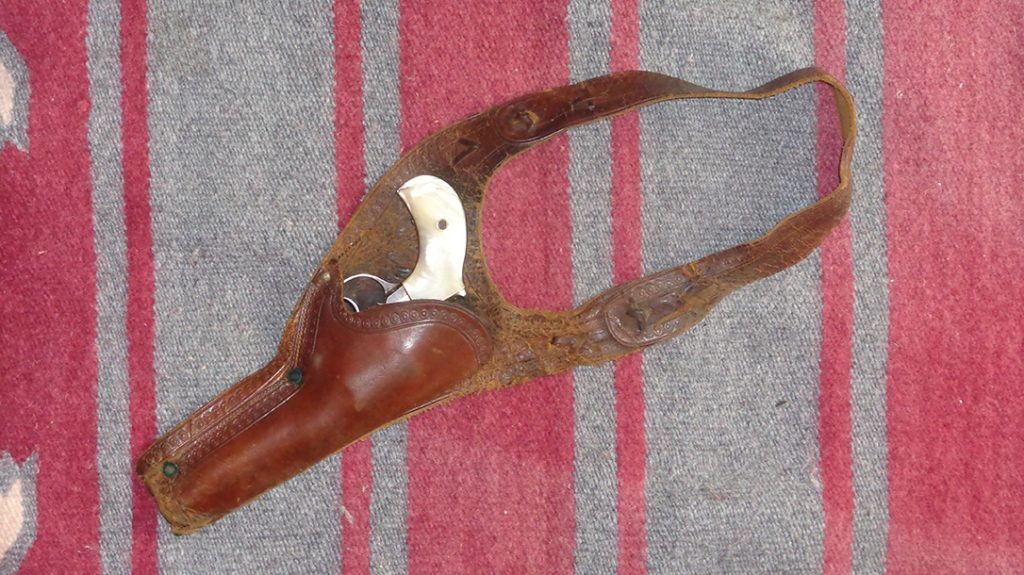
By the late 1890s, a much-improved “clip spring” or “skeleton” model was available. It is believed that this shoulder holster type may be the collaboration of two Montana saddlers—Al Furstnow of Miles City and E.D. Zimmerman of nearby Custer County—who began producing the model at about the same time. This holster style consisted of stiff, two-ply contoured backing. It featured a single, leather-covered steel spring band, or strap. That strap supported the frame of the weapon. Meanwhile, a small socket at the base of the backing held the muzzle in place.
Advertisement — Continue Reading Below
What About Women and Old West Guns?
Men weren’t the only ones packing iron in the Old West. General Custer’s wife, Elizabeth, described a woman at a U.S. Army post who had carried a tiny Remington pistol and “promised to teach us to put in the cartridge and discharge the piece … It was not much larger than a lead-pencil, and we could not help doubting its power to damage.” She also said, “We had to laugh at the vehement manner in which she declared that she could disable the leg of an enemy.”
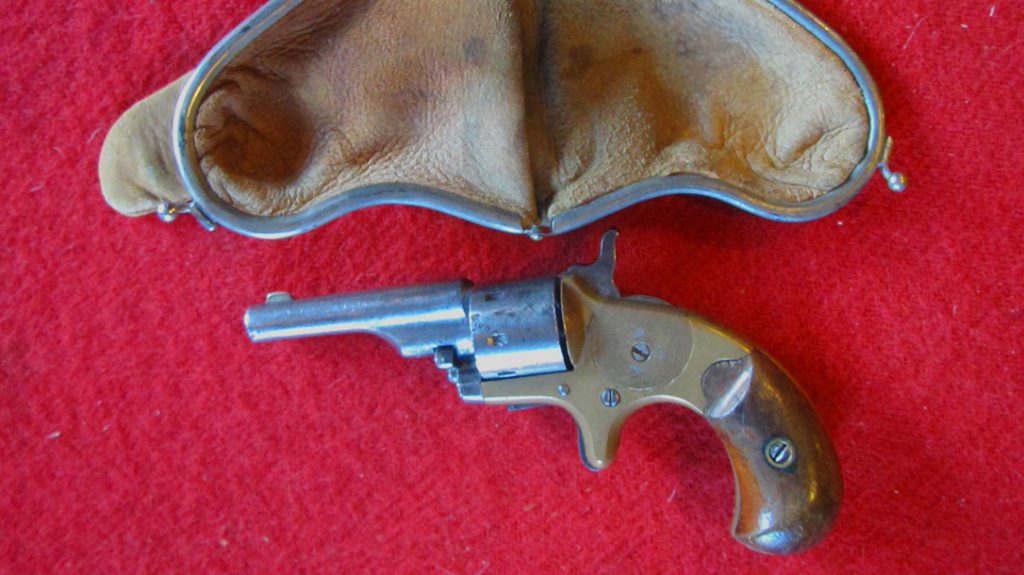
Advertisement — Continue Reading Below
The bulky clothing worn by women of that era afforded a multitude of hiding places. It was a simple matter for a woman to rig a small holster to her stocking garter or attach a tiny derringer to a string and tuck it safely out of sight in her apparel. For that matter, almost any sized handgun is concealed well within the folds of a Victorian-era skirt or bustle. In colder climes, women often wore fur muffs to keep their hands warm. Some companies advertised muff pistols. While using this garment, a small pistol could easily be kept out of sight and at the ready.
Concealed Carry
Interestingly, Continental Arms Company manufactured a small five-shot, .22-caliber pepperbox invented by Charles Converse and Samuel Hopkins in August 1866. Manufactured in small quantities (about 1,000 pistols), the pistols sold under the trade name “Ladies Companion”. Only a few reached the Western market, as they lacked wide favor. Regardless of the method of Concealed carry, many folks considered themselves undressed, or “not properly heeled,” when not packing iron. You just wouldn’t see it.
